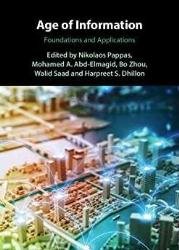 Название: Age of Information: Foundations and Applications
Название: Age of Information: Foundations and ApplicationsАвтор: Nikolaos Pappas, Mohamed A. Abd-Elmagid, Bo Zhou
Издательство: Cambridge University Press
Год: 2023
Страниц: 495
Язык: английский
Формат: pdf
Размер: 49.5 MB
At the forefront of cutting-edge technologies, this text provides a comprehensive treatment of a crucial network performance metric, ushering in new opportunities for rethinking the whole design of communication systems. Detailed exposition of the communication and network theoretic foundations of Age of Information (AoI) gives the reader a solid background, and discussion of the implications on signal processing and control theory shed light on the important potential of recent research. The text includes extensive real-world applications of this vital metric, including caching, the Internet of Things (IoT), and energy harvesting networks. The far-reaching applications of AoI include networked monitoring systems, cyber-physical systems such as the IoT, and information-oriented systems and data analytics applications ranging from the stock market to social networks. The future of this exciting subject in 5G communication systems and beyond make this a vital resource for graduate students, researchers and professionals.
In this chapter, we study the age of information (AoI) when status updates of an underlying process of interest, sampled and recorded by a source node, must be transmitted to one or more destination nodes over error-prone wireless channels. We consider the practical setting, in which the statistics of the system are not known a priori, and must be learned in an online fashion. This requires designing (RL) algorithms that can adapt their policy dynamically through interactions with the environment. Accordingly, the aim of this chapter is to design and analyze RL algorithms to minimize the average AoI at the destination nodes, taking into account retransmissions due to channel errors.
Retransmissions are essential for providing reliability of status updates over error-prone channels, particularly in wireless settings, and are incorporated into almost all wireless communication standards. In the standard automatic repeat request (ARQ) protocol, failed transmissions are repeated until they are successfully received, or a maximum retransmission count is reached. Some of the recent standards including ZigBee (Alliance 2008), Bluetooth IEEE 802.15.1, WiFi IEEE 802.11ac, and UWB (Ultra-wideband) IEEE 802.15.4a (Oppermann, Hamalainen, & Iinatti 2004) use cyclic redundancy check (CRC) together with ARQ. On the other hand, in the hybrid ARQ (HARQ) protocol, the receiver combines information from previous transmission attempts of the same packet in order to increase the success probability of decoding. Recent communication standards including IEEE 802.16m, 3GPP LTE, LTE-A (E-UTRA 2013), IEEE 802.11be, and Narrow Band IoT (NB-IoT) have adopted HARQ techniques to enhance the system performance, typically through a combination of CRC and forward error correction (FEC) (802.16e 2005 2006). In this chapter, we study both ARQ and HARQ protocols for the minimization of AoI.
Reinforcement Learning (RL) is an important area of machine learning where a learning agent learns how to behave in an environment by performing actions and observing the results of its actions in the form of state transitions and costs in order to learn to minimize some notion of cumulative cost Sutton and Barto. In recent years, RL methods have attracted significant attention thanks to groundbreaking achievements in this area of research.
Timeliness is an emerging requirement for a variety of wireless services like unmanned grocery, industrial Internet-of-Things, and vehicular communications, as well as the likes of mobile applications. As a result, this obliges network designers to develop systems that ensure timeliness of information delivery. Recognizing the limitation in conventional latency metrics (e.g., delay or throughput) as not being able to account for such “information lag” in a time-varying environment, there emerges a new metric, namely the age of information (AoI), to quantify the freshness of a typical piece of information. This notion was originally conceived to maintain timely status update in a standard first-come-first-served (FCFS) queue. Soon after that, a host of research has been conducted to investigate different schemes aimed at minimizing the AoI, whereas the results range from controlling the update generating policy, deploying last-come-first-served (LCFS) queue, to proactively discarding stale packets at the source node. Although these works have extensively explored the minimization of the information age on a single-node basis, many fundamental questions, especially those pertaining to large-scale networks, are not understood satisfactorily. To that end, it spurred a series of studies seeking different approaches, mainly in the form of scheduling protocols, to optimize information freshness in the context of wireless networks.
Скачать Age of Information: Foundations and Applications